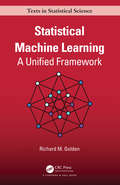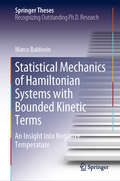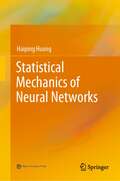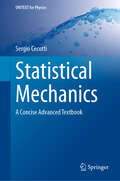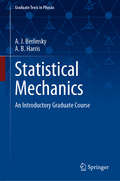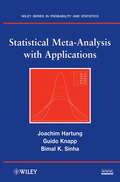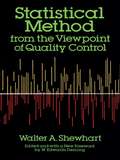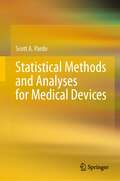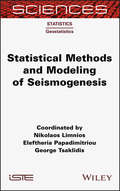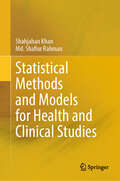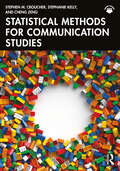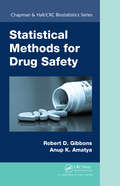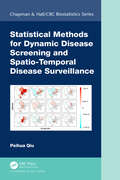- Table View
- List View
Statistical Machine Learning: A Unified Framework (Chapman & Hall/CRC Texts in Statistical Science)
by Richard GoldenThe recent rapid growth in the variety and complexity of new machine learning architectures requires the development of improved methods for designing, analyzing, evaluating, and communicating machine learning technologies. Statistical Machine Learning: A Unified Framework provides students, engineers, and scientists with tools from mathematical statistics and nonlinear optimization theory to become experts in the field of machine learning. In particular, the material in this text directly supports the mathematical analysis and design of old, new, and not-yet-invented nonlinear high-dimensional machine learning algorithms. Features: Unified empirical risk minimization framework supports rigorous mathematical analyses of widely used supervised, unsupervised, and reinforcement machine learning algorithms Matrix calculus methods for supporting machine learning analysis and design applications Explicit conditions for ensuring convergence of adaptive, batch, minibatch, MCEM, and MCMC learning algorithms that minimize both unimodal and multimodal objective functions Explicit conditions for characterizing asymptotic properties of M-estimators and model selection criteria such as AIC and BIC in the presence of possible model misspecification This advanced text is suitable for graduate students or highly motivated undergraduate students in statistics, computer science, electrical engineering, and applied mathematics. The text is self-contained and only assumes knowledge of lower-division linear algebra and upper-division probability theory. Students, professional engineers, and multidisciplinary scientists possessing these minimal prerequisites will find this text challenging yet accessible. About the Author: Richard M. Golden (Ph.D., M.S.E.E., B.S.E.E.) is Professor of Cognitive Science and Participating Faculty Member in Electrical Engineering at the University of Texas at Dallas. Dr. Golden has published articles and given talks at scientific conferences on a wide range of topics in the fields of both statistics and machine learning over the past three decades. His long-term research interests include identifying conditions for the convergence of deterministic and stochastic machine learning algorithms and investigating estimation and inference in the presence of possibly misspecified probability models.
Statistical Machine Translation
by Philipp KoehnThe filed of machine translation has recently been energized by the emergence of statistical techniques, which have brought the dream of automatic language translation closer to reality. This class-tested textbook, authored by an active researcher in the field, provides a gentle and accessible introduction to the latest methods and enables the reader to build machine translation systems for any language pair.
Statistical Mechanics
by Richard P. FeynmanPhysics, rather than mathematics, is the focus in this classic graduate lecture note volume on statistical mechanics and the physics of condensed matter. This book provides a concise introduction to basic concepts and a clear presentation of difficult topics, while challenging the student to reflect upon as yet unanswered questions.
Statistical Mechanics of Classical and Disordered Systems: Luminy, France, August 2018 (Springer Proceedings in Mathematics & Statistics #293)
by Véronique Gayrard Nicola Kistler Louis-Pierre Arguin Irina KourkovaThese proceedings of the conference Advances in Statistical Mechanics, held in Marseille, France, August 2018, focus on fundamental issues of equilibrium and non-equilibrium dynamics for classical mechanical systems, as well as on open problems in statistical mechanics related to probability, mathematical physics, computer science, and biology. Statistical mechanics, as envisioned more than a century ago by Boltzmann, Maxwell and Gibbs, has recently undergone stunning twists and developments which have turned this old discipline into one of the most active areas of truly interdisciplinary and cutting-edge research. The contributions to this volume, with their rather unique blend of rigorous mathematics and applications, outline the state-of-the-art of this success story in key subject areas of equilibrium and non-equilibrium classical and quantum statistical mechanics of both disordered and non-disordered systems. Aimed at researchers in the broad field of applied modern probability theory, this book, and in particular the review articles, will also be of interest to graduate students looking for a gentle introduction to active topics of current research.
Statistical Mechanics of Hamiltonian Systems with Bounded Kinetic Terms: An Insight into Negative Temperature (Springer Theses)
by Marco BaldovinRecent experimental evidence about the possibility of "absolute negative temperature" states in physical systems has triggered a stimulating debate about the consistency of such a concept from the point of view of Statistical Mechanics. It is not clear whether the usual results of this field can be safely extended to negative-temperature states; some authors even propose fundamental modifications to the Statistical Mechanics formalism, starting with the very definition of entropy, in order to avoid the occurrence of negative values of the temperature tout-court.The research presented in this thesis aims to shed some light on this controversial topic. To this end, a particular class of Hamiltonian systems with bounded kinetic terms, which can assume negative temperature, is extensively studied, both analytically and numerically. Equilibrium and out-of-equilibrium properties of this kind of system are investigated, reinforcing the overall picture that the introduction of negative temperature does not lead to any contradiction or paradox.
Statistical Mechanics of Lattice Systems: A Concrete Mathematical Introduction
by Sacha Friedli Yvan VelenikThis motivating textbook gives a friendly, rigorous introduction to fundamental concepts in equilibrium statistical mechanics, covering a selection of specific models, including the Curie–Weiss and Ising models, the Gaussian free field, O(n) models, and models with Kać interactions. Using classical concepts such as Gibbs measures, pressure, free energy, and entropy, the book exposes the main features of the classical description of large systems in equilibrium, in particular the central problem of phase transitions. It treats such important topics as the Peierls argument, the Dobrushin uniqueness, Mermin–Wagner and Lee–Yang theorems, and develops from scratch such workhorses as correlation inequalities, the cluster expansion, Pirogov–Sinai Theory, and reflection positivity. Written as a self-contained course for advanced undergraduate or beginning graduate students, the detailed explanations, large collection of exercises (with solutions), and appendix of mathematical results and concepts also make it a handy reference for researchers in related areas. Builds a narrative around the driving concepts, focusing on specific examples and models. Self-contained and accessible. Features numerous exercises and solutions, as well as a comprehensive appendix.
Statistical Mechanics of Neural Networks
by Haiping HuangThis book highlights a comprehensive introduction to the fundamental statistical mechanics underneath the inner workings of neural networks. The book discusses in details important concepts and techniques including the cavity method, the mean-field theory, replica techniques, the Nishimori condition, variational methods, the dynamical mean-field theory, unsupervised learning, associative memory models, perceptron models, the chaos theory of recurrent neural networks, and eigen-spectrums of neural networks, walking new learners through the theories and must-have skillsets to understand and use neural networks. The book focuses on quantitative frameworks of neural network models where the underlying mechanisms can be precisely isolated by physics of mathematical beauty and theoretical predictions. It is a good reference for students, researchers, and practitioners in the area of neural networks.
Statistical Mechanics: A Concise Advanced Textbook (UNITEXT for Physics)
by Sergio CecottiThis textbook is based on lecture notes that the author delivered at Qiuzhen College (Tsinghua University), a Chinese institution known for its exceptionally talented mathematics students. The book's intended audience shapes its character. It introduces Statistical Mechanics from the ground up, offering a fully self-contained presentation that aims for mathematical precision. It distinguishes rigorous results from controlled approximations and provides physical insights into phenomena. Despite its concise nature (suited for a one-semester basic course), this book covers several topics typically not found in introductory texts. These include Shannon's information-theoretic interpretation of entropy, the gauge approach to order-disorder duality in the Ising model, the Yang-Lee theory, and the quantum dissipation-fluctuation theorem. Additionally, it explores frustrated and quenched systems, including an introduction to the celebrated Parisi solution of the Sherrington-Kirkpatrick model of spin glasses. The path integral formalism is extensively discussed from various perspectives to suit different applications. Chapter 2 approaches path integrals through the Feynman-Kac formula and second quantization. In Chapter 5, they are examined within the context of effective field theories like Landau-Ginzburg theory, while Chapter 6 delves into their connection with Brownian motion, Langevin stochastic differential equations, and Fokker-Planck diffusion PDEs. The book also explores the relationship between stochastic processes and supersymmetry. Various techniques for computing path integrals, especially functional determinants, are introduced throughout the relevant chapters, offering the most suitable computational tools for each application.
Statistical Mechanics: An Introductory Graduate Course (Graduate Texts in Physics)
by A. J. Berlinsky A. B. HarrisIn a comprehensive treatment of Statistical Mechanics from thermodynamics through the renormalization group, this book serves as the core text for a full-year graduate course in statistical mechanics at either the Masters or Ph.D. level. Each chapter contains numerous exercises, and several chapters treat special topics which can be used as the basis for student projects. The concept of scaling is introduced early and used extensively throughout the text. At the heart of the book is an extensive treatment of mean field theory, from the simplest decoupling approach, through the density matrix formalism, to self-consistent classical and quantum field theory as well as exact solutions on the Cayley tree. Proceeding beyond mean field theory, the book discusses exact mappings involving Potts models, percolation, self-avoiding walks and quenched randomness, connecting various athermal and thermal models. Computational methods such as series expansions and Monte Carlo simulations are discussed, along with exact solutions to the 1D quantum and 2D classical Ising models. The renormalization group formalism is developed, starting from real-space RG and proceeding through a detailed treatment of Wilson’s epsilon expansion. Finally the subject of Kosterlitz-Thouless systems is introduced from a historical perspective and then treated by methods due to Anderson, Kosterlitz, Thouless and Young. Altogether, this comprehensive, up-to-date, and engaging text offers an ideal package for advanced undergraduate or graduate courses or for use in self study.
Statistical Mechanics: Fundamentals and Model Solutions
by Teunis C DorlasStatistical Mechanics: Fundamentals and Model Solutions, Second Edition Fully updated throughout and with new chapters on the Mayer expansion for classical gases and on cluster expansion for lattice models, this new edition of Statistical Mechanics: Fundamentals and Model Solutions provides a comprehensive introduction to equilibrium statistical mechanics for advanced undergraduate and graduate students of mathematics and physics. The author presents a fresh approach to the subject, setting out the basic assumptions clearly and emphasizing the importance of the thermodynamic limit and the role of convexity. With problems and solutions, the book clearly explains the role of models for physical systems, and discusses and solves various models. An understanding of these models is of increasing importance as they have proved to have applications in many areas of mathematics and physics. Features Updated throughout with new content from the field An established and well-loved textbook Contains new problems and solutions for further learning opportunity Author Professor Teunis C. Dorlas is at the Dublin Institute for Advanced Studies, Ireland.
Statistical Meta-Analysis with Applications
by Bimal K. Sinha Guido Knapp Joachim HartungAn accessible introduction to performing meta-analysis across various areas of researchThe practice of meta-analysis allows researchers to obtain findings from various studies and compile them to verify and form one overall conclusion. Statistical Meta-Analysis with Applications presents the necessary statistical methodologies that allow readers to tackle the four main stages of meta-analysis: problem formulation, data collection, data evaluation, and data analysis and interpretation. Combining the authors' expertise on the topic with a wealth of up-to-date information, this book successfully introduces the essential statistical practices for making thorough and accurate discoveries across a wide array of diverse fields, such as business, public health, biostatistics, and environmental studies.Two main types of statistical analysis serve as the foundation of the methods and techniques: combining tests of effect size and combining estimates of effect size. Additional topics covered include:Meta-analysis regression proceduresMultiple-endpoint and multiple-treatment studiesThe Bayesian approach to meta-analysisPublication biasVote counting proceduresMethods for combining individual tests and combining individual estimatesUsing meta-analysis to analyze binary and ordinal categorical dataNumerous worked-out examples in each chapter provide the reader with a step-by-step understanding of the presented methods. All exercises can be computed using the R and SAS software packages, which are both available via the book's related Web site. Extensive references are also included, outlining additional sources for further study.Requiring only a working knowledge of statistics, Statistical Meta-Analysis with Applications is a valuable supplement for courses in biostatistics, business, public health, and social research at the upper-undergraduate and graduate levels. It is also an excellent reference for applied statisticians working in industry, academia, and government.
Statistical Method from the Viewpoint of Quality Control
by Walter A. ShewhartImportant text offers lucid explanation of how to regulate variables and maintain control over statistics in order to achieve quality control over manufactured products, crops and data. Topics include statistical control, establishing limits of variability, measurements of physical properties and constants, and specification of accuracy and precision. First inexpensive paperback edition.
Statistical Methodologies with Medical Applications
by Poduri Srs RaoThis book presents the methodology and applications of a range of important topics in statistics, and is designed for graduate students in Statistics and Biostatistics and for medical researchers. Illustrations and more than ninety exercises with solutions are presented. They are constructed from the research findings of the medical journals, summary reports of the Centre for Disease Control (CDC) and the World Health Organization (WHO), and practical situations. The illustrations and exercises are related to topics such as immunization, obesity, hypertension, lipid levels, diet and exercise, harmful effects of smoking and air pollution, and the benefits of gluten free diet. This book can be recommended for a one or two semester graduate level course for students studying Statistics, Biostatistics, Epidemiology and Health Sciences. It will also be useful as a companion for medical researchers and research oriented physicians.
Statistical Methods For Geography a Student's Guide
by Peter A. Rogerson'This book provides students with everything they need to know in both a basic statistics course and also in introductory courses focused on spatial data analysis. It is extremely well-written, well-organised and has plenty of easily understood examples - really the ideal textbook. I recommend it extremely highly' - Stewart Fotheringham, Director, National Centre for Geocomputation National University of Ireland Maynooth The Third Edition of this bestselling student favourite has again been revised and updated to provide an expert introduction to the principal methods and techniques needed to understand a statistics module. Features new to this edition include: - further introductory material - updated exercises and illustrative examples - updated downloadable datasets
Statistical Methods Using SPSS
by Gabriel Otieno OkelloStatistical Methods Using SPSS provides a practical approach for better understanding of the advanced statistical concepts that are applied in business, economics, epidemiology, public health, agriculture and other areas of data analytics. Advanced statistical methods or advanced statistical techniques for analyzing data arise because of the complex nature of data sets that cannot be analyzed using the basic or the usual and common analytical techniques. This book describes more advanced statistical methods, offering a modern approach by introducing the advanced statistical concepts, before showing the application of these concepts in real-world examples with the application of SPSS statistical software.This book is useful in explaining advanced statistical analysis techniques to postgraduate students, doctoral students and researchers. It is also a useful reference for students and researchers who require further guidance in advanced data analysis and is designed for those with basic statistical knowledge. Exercises are also included at the end of each chapter to aid in the understanding of the statistical analysis techniques explained in the book.Key features: there are many topics on advanced statistical techniques, a provision of theoretical statistical concepts, there is a step-by-step guide for the different statistical analysis techniques being done using SPSS, there are variety of data set examples to help explain the different statistical concepts, and there is a practical applications of the statistical concepts in SPSS.
Statistical Methods and Analyses for Medical Devices
by Scott A. PardoThis book provides a reference for people working in the design, development, and manufacturing of medical devices. While there are no statistical methods specifically intended for medical devices, there are methods that are commonly applied to various problems in the design, manufacturing, and quality control of medical devices. The aim of this book is not to turn everyone working in the medical device industries into mathematical statisticians; rather, the goal is to provide some help in thinking statistically, and knowing where to go to answer some fundamental questions, such as justifying a method used to qualify/validate equipment, or what information is necessary to support the choice of sample sizes.While, there are no statistical methods specifically designed for analysis of medical device data, there are some methods that seem to appear regularly in relation to medical devices. For example, the assessment of receiver operating characteristic curves is fundamental to development of diagnostic tests, and accelerated life testing is often critical for assessing the shelf life of medical device products. Another example is sensitivity/specificity computations are necessary for in-vitro diagnostics, and Taguchi methods can be very useful for designing devices. Even notions of equivalence and noninferiority have different interpretations in the medical device field compared to pharmacokinetics. It contains topics such as dynamic modeling, machine learning methods, equivalence testing, and experimental design, for example.This book is for those with no statistical experience, as well as those with statistical knowledgeable—with the hope to provide some insight into what methods are likely to help provide rationale for choices relating to data gathering and analysis activities for medical devices.
Statistical Methods and Applications in Forestry and Environmental Sciences (Forum for Interdisciplinary Mathematics)
by Girish Chandra Raman Nautiyal Hukum ChandraThis book presents recent developments in statistical methodologies with particular relevance to applications in forestry and environmental sciences. It discusses important methodologies like ranked set sampling, adaptive cluster sampling, small area estimation, calibration approach-based estimators, design of experiments, multivariate techniques, Internet of Things, and ridge regression methods. It also covers the history of the implementation of statistical techniques in Indian forestry and the National Forest Inventory of India.The book is a valuable resource for applied statisticians, students, researchers, and practitioners in the forestry and environment sector. It includes real-world examples and case studies to help readers apply the techniques discussed. It also motivates academicians and researchers to use new technologies in the areas of forestry and environmental sciences with the help of software like R, MATLAB, Statistica, and Mathematica.
Statistical Methods and Applications in Systems Assurance and Quality (Advanced Research in Reliability and System Assurance Engineering)
by Sotiris Bersimis Polychronis Economou Athanasios RakitzisIn the era of big data and real-time monitoring, vast amounts of information are generated every second through sensors and advanced tracking systems. The information contained in the data needs to be carefully analyzed and accurate results must be delivered to the users as soon as possible. This book explores the critical role of statistics in modern technologies and applied sciences such as health, informatics, and production systems.Statistical Methods and Applications in Systems Assurance and Quality provides a comprehensive overview of statistical methods for ensuring system quality and reliability. It discusses best practices for improving the quality of manufacturing products by using proper statistical methods. The book covers the current state of statistical methods used for system quality and conveys the importance of healthcare systems and employing statistics in the detection of epidemic outbreaks.Designed for researchers, industry professionals, and academics, this reference is ideal for those working in manufacturing, healthcare, computer engineering, statistical process control, and machine learning applications. It serves as a valuable resource for anyone seeking to enhance system performance through data-driven insights.
Statistical Methods and Modeling of Seismogenesis
by Nikolaos Limnios Eleftheria Papadimitriou George TsaklidisThe study of earthquakes is a multidisciplinary field, an amalgam of geodynamics, mathematics, engineering and more. The overriding commonality between them all is the presence of natural randomness. Stochastic studies (probability, stochastic processes and statistics) can be of different types, for example, the black box approach (one state), the white box approach (multi-state), the simulation of different aspects, and so on. This book has the advantage of bringing together a group of international authors, known for their earthquake-specific approaches, to cover a wide array of these myriad aspects. A variety of topics are presented, including statistical nonparametric and parametric methods, a multi-state system approach, earthquake simulators, post-seismic activity models, time series Markov models with regression, scaling properties and multifractal approaches, selfcorrecting models, the linked stress release model, Markovian arrival models, Poisson-based detection techniques, change point detection techniques on seismicity models, and, finally, semi-Markov models for earthquake forecasting.
Statistical Methods and Models for Health and Clinical Studies
by Shahjahan Khan Md. Shafiur RahmanThis book addresses the need for statistical knowledge and skills among health professionals and researchers by presenting statistical concepts, methods and models in a health and clinical context, making it distinct from traditional textbooks. By using real-life examples and motivational scenarios from health studies, the book explains all relevant concepts and methods in an engaging and accessible manner, avoiding unnecessary mathematical jargon. Every chapter of the book starts with a set of learning outcomes to guide the researchers and users. Special attention is given to explaining statistical concepts with examples from various health areas, ensuring clarity and understanding. The book covers a wide range of topics, including data description and collection, study designs, inferential methods, statistical model fittings, and data analysis using SPSS, R, and STATA codes. Readers are provided with step-by-step guidance with illustrations, making it easier to follow along and apply the techniques discussed, and interpretation of results in the context of the problem. The book highlights the importance of statistics in solving health and clinical problems, equipping readers with the essential tools and strategies needed for evidence-based decision-making. By focusing on practical examples and real-world applications, this book serves as an invaluable resource for health professionals and researchers offering valuable insights and practical advice to help navigate the complexities of statistical analysis in the health and clinical fields.
Statistical Methods for Cancer Studies
by Richard G. CornellThis book focuses on public health and epidemiologic aspects of cancer, and explores the sources of information concerning the frequency of occurrence of human cancer. It describes statistical methods useful in studying problems arising in the field of cancer and its concurrent development.
Statistical Methods for Communication Science (Routledge Communication Series)
by Andrew F. HayesStatistical Methods for Communication Science is the only statistical methods volume currently available that focuses exclusively on statistics in communication research. Writing in a straightforward, personal style, author Andrew F. Hayes offers this accessible and thorough introduction to statistical methods, starting with the fundamentals of measurement and moving on to discuss such key topics as sampling procedures, probability, reliability, hypothesis testing, simple correlation and regression, and analyses of variance and covariance. Hayes takes readers through each topic with clear explanations and illustrations. He provides a multitude of examples, all set in the context of communication research, thus engaging readers directly and helping them to see the relevance and importance of statistics to the field of communication.Highlights of this text include:*thorough and balanced coverage of topics;*integration of classical methods with modern "resampling" approaches to inference;*consideration of practical, "real world" issues;*numerous examples and applications, all drawn from communication research;*up-to-date information, with examples justifying use of various techniques; and*a CD with macros, data sets, figures, and additional materials.This unique book can be used as a stand-alone classroom text, a supplement to traditional research methods texts, or a useful reference manual. It will be invaluable to students, faculty, researchers, and practitioners in communication, and it will serve to advance the understanding and use of statistical methods throughout the discipline.
Statistical Methods for Communication Studies
by Stephen M. Croucher Cheng Zeng Stephanie KellyA step-by-step guide through various stages of data preparation and analysis, this text demonstrates descriptive and inferential statistics in communication studies.This book equips communication students with the tools they need to engage in quantitative research, ensuring that they understand why the statistical tools they chose are most appropriate for their data. Using examples and data directly relevant to communication researchers, this text provides guidance on how to use and interpret SPSS and write up results, with further guidance via free online material in using Excel and R. Instead of focusing on formulas and in-depth mathematics, this book provides a hands-on approach to understanding the theory, practice, and application of statistical methods in communication. In addition to covering the standard statistical tools used to analyze social science data for hypothesis testing (e.g., correlation, regression, ANOVA), it also covers advanced factor-analytic techniques specific to measurement validation as well as data visualization guidance.Ideally suited for statistics or quantitative methods courses in communication studies programs at the advanced and graduate level.Online resources include tutorials on SPSS, Excel, and R for key constructs and practice quizzes for students. Instructors will find an instructor manual and test bank. Please visit www.routledge.com/9781032814872.
Statistical Methods for Drug Safety (Chapman & Hall/CRC Biostatistics Series)
by Robert D. Gibbons Anup AmatyaExplore Important Tools for High-Quality Work in Pharmaceutical SafetyStatistical Methods for Drug Safety presents a wide variety of statistical approaches for analyzing pharmacoepidemiologic data. It covers both commonly used techniques, such as proportional reporting ratios for the analysis of spontaneous adverse event reports, and newer approach
Statistical Methods for Dynamic Disease Screening and Spatio-Temporal Disease Surveillance (Chapman & Hall/CRC Biostatistics Series)
by Peihua QiuDisease screening and disease surveillance (DSDS) constitute two critical areas in public health, each presenting distinctive challenges primarily due to their sequential decision-making nature and complex data structures. Statistical Methods for Dynamic Disease Screening and Spatio-Temporal Disease Surveillance explores numerous recent analytic methodologies that enhance traditional techniques. The author, a prominent researcher specializing in innovative sequential decision-making techniques, demonstrates how these novel methods effectively address the challenges of DSDS.After a concise introduction that lays the groundwork for comprehending the challenges inherent in DSDS, the book delves into fundamental statistical concepts and methods relevant to DSDS. This includes exploration of statistical process control (SPC) charts specifically crafted for sequential decision-making purposes. The subsequent chapters systematically outline recent advancements in dynamic screening system (DySS) methods, fine-tuned for effective disease screening. Additionally, the text covers both traditional and contemporary analytic methods for disease surveillance. It further introduces two recently developed R packages designed for implementing DySS methods and spatio-temporal disease surveillance techniques pioneered by the author's research team.Features• Presents Recent Analytic Methods for DSDS: The book introduces analytic methods for DSDS based on SPC charts. These methods effectively utilize all historical data, accommodating the complex data structure inherent in sequential decision-making processes.• Introduces Recent R Packages: Two recent R packages, DySS and SpTe2M, are introduced. The book not only presents these packages but also demonstrates key DSDS methods using them.• Examines Recent Research Results: The text delves into the latest research findings across various domains, including dynamic disease screening, nonparametric spatio-temporal data modeling and monitoring, and spatio-temporal disease surveillance.• Accessible Description of Methods: Major methods are described in a manner accessible to individuals without advanced knowledge in mathematics and statistics. The goal is to facilitate a clear understanding of ideas and easy implementation.• Real-Data Examples: To aid comprehension, the book provides several real-data examples illustrating key concepts and methods.• Hands-on Exercises: Each chapter includes exercises to encourage hands-on practice, allowing readers to engage directly with the presented methods.
